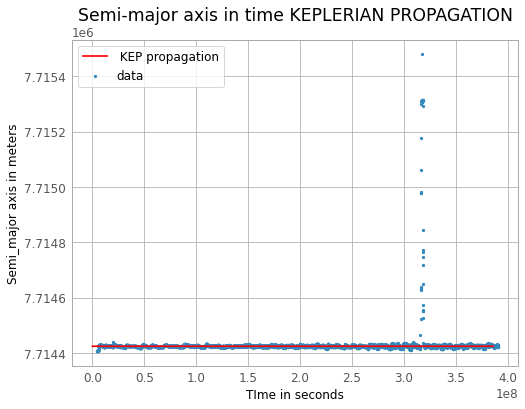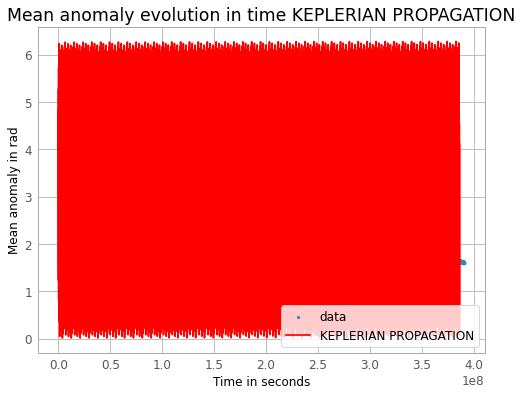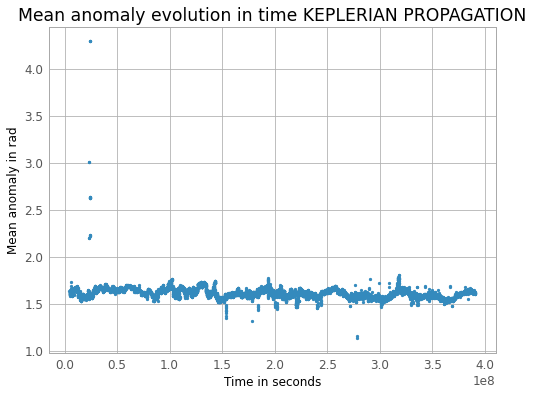Hello orekit community,
I just created a function to propagate with the keplerian propagator knowing an initial conditon E0, a initial time, a final time and the inertialFrame. Where E0 = [a,e,i,pa,raan,M], the keplerian orbital parameters.
Here is the function I designed :
def Keplerian_propagation(E0, central_mu, initialDate, finalDate, inertialFrame, nbr_pts):
'''
ARGS :
E0 : Initial Vector [a0,e0,i0,pa0,raan0,M0]
central_mu : mu of the central body (here the earth)
initialDate : AbsoluteDate of the initial time
finalDate : AbsoluteDate of the final time when the propagation must stop
inertialFrame : Inertial Frame of reference used in the construction of orbits and propagation
nbr_pts : Number of points for the propagation
'''
# Keplerian parameters
prop_a,prop_e,prop_i,prop_pa,prop_raan,prop_M,prop_orbits, prop_LM = [],[],[],[],[],[],[],[]
# Equinoctial parameters :
prop_Hx, prop_Hy, prop_Ex, prop_Ey = [],[],[],[]
step = finalDate.durationFrom(initialDate)/nbr_pts
a0,e0,i0,pa0,raan0,M0 = E0[0],E0[1],E0[2],E0[3],E0[4],E0[5]
extrapDate=initialDate
orbit0 = KeplerianOrbit(float(a0), float(e0) , float(i0), float(pa0), float(raan0), float(M0), PositionAngle.MEAN, inertialFrame, extrapDate, central_mu)
propagator = KeplerianPropagator(orbit0)
while (extrapDate.compareTo(finalDate) <= 0.0):
orbit = propagator.propagate(extrapDate, extrapDate.shiftedBy(float(step))).getOrbit()
PV = orbit.getPVCoordinates()
keplerian = KeplerianOrbit(PV,inertialFrame,extrapDate,central_mu)
prop_a.append(keplerian.getA())
prop_e.append(keplerian.getE())
prop_i.append(keplerian.getI())
prop_Hx.append(keplerian.getHx())
prop_Hy.append(keplerian.getHy())
prop_Ex.append(keplerian.getEquinoctialEx())
prop_Ey.append(keplerian.getEquinoctialEy())
prop_LM.append(keplerian.getLM())
##### RAAN and PA calculations and normalization from Equinoctial parameters
to_check_raan = float(np.arctan2(prop_Hy[-1],prop_Hx[-1]))
moduled_raan = to_check_raan % float(mytwopi)
prop_raan.append(moduled_raan)
# Now we have raan, we also know that ex = e * cos(raan + pa) so pa = arccos(ex/e) - raan
to_check_pa = float(np.arctan2(prop_Ey[-1],prop_Ex[-1])-prop_raan[-1])
moduled_pa = to_check_pa % float(mytwopi)
prop_pa.append(moduled_pa)
prop_M.append((prop_LM[-1] - prop_raan[-1] - prop_pa[-1]) % (2*np.pi))
props_orbits.append(KeplerianOrbit(prop_a[-1],prop_e[-1],prop_i[-1],prop_pa[-1],prop_raan[-1],prop_M[-1], PositionAngle.MEAN, inertialFrame, extrapDate, mu))
extrapDate = extrapDate.shiftedBy(float(step))
return prop_a,prop_e,prop_i,prop_pa,prop_raan,prop_M,prop_orbits
I entered the following parameters in input :
E0 = [ 7714425.10389488 , 0.00074884, 1.15259588, 4.64377019, 3.14044603, 1.66140363]
mu = 398600441800000.0 km^3/s².
initialDate = <AbsoluteDate: 1992-10-04T02:26:25.28592Z>
finalDate = <AbsoluteDate: 2004-12-30T10:05:34.201536Z>
inertialFrame = <FactoryManagedFrame: EME2000>
nbr_pts = 8621
The propagation is done for the satellite Topex.
The aim of this propagation is to obtain the keplerian parameters through time. Here is what I got as an example (as expected for the semi-major axis) :
(In red the keplerian propagation in blue the original data from a TLE)

But, here is where it’s problematic, all keplerian parameters are correct except the mean anomaly :

While the data (from TLE) look like that :

I don’t understand what I did wrong here, while all the others parameters seems fine.
Thank you in advance
Julien L.